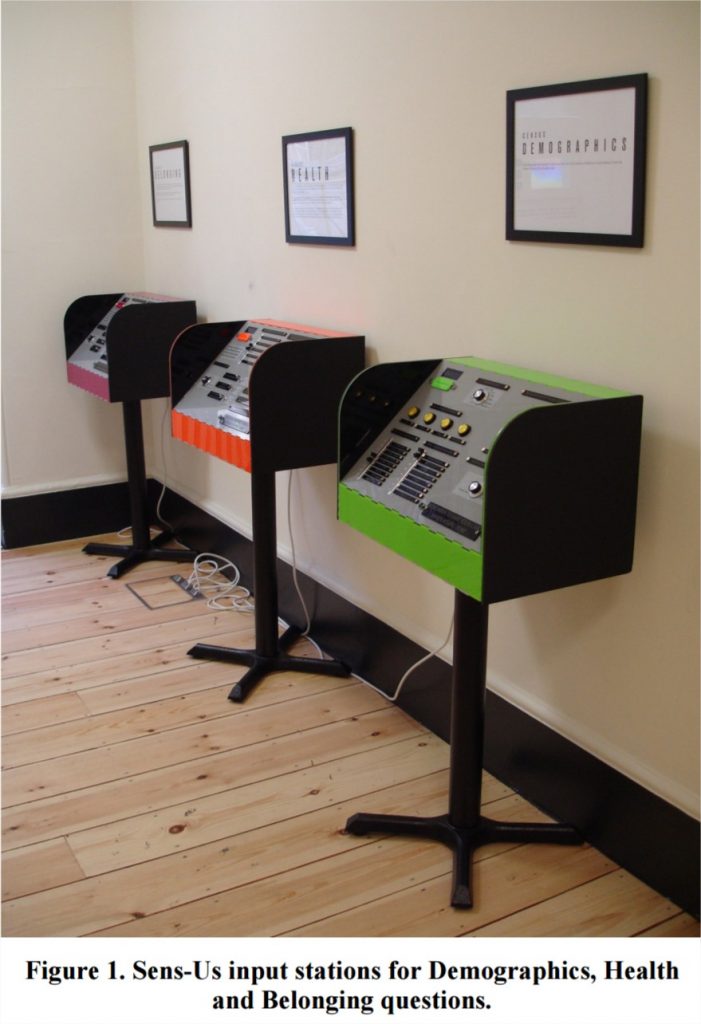Buttons for Participation
Physical and tangible systems are increasingly being explored in an attempt to trigger discussions and collect data in the context of Digital Civics; the novelty of the experience seems to boost engagement, the local nature of it brings people together in debating and conversing about topics of relation, but the usual questions of privacy, engagement, and participation always come up.
Based on the general interest of the UK government in exploring technology possibilities in data collection, the organizers of the UK Census team’s Civic Workshop asked the authors to design an interactive census experiment to be deployed during the workshop. What the team came up with was an interesting system, consisting of five tangible consoles (boxes), each asking a set of questions, and a “pillar” of data visualization, showing the answers. A respondent can access a console using a disposable NFC card, which they later use to access other boxes, and finally the data visualization.

The system was deployed for four weeks in a census bureau styled room in Somerset House, a major arts and cultural centre in London. During the four weeks of deployment 731 people interacted with at least one of the boxes, 33% of whom completed all the questions in the five boxes. While privacy was a major concern when designing the system, people did not seem generally concerned with privacy. A lot of the participants found comparing their data to others using the visualisation pillars interesting, and in some cases that visualisation pillar motivated people to answer more questions to compare even more data.
The primary concern of the experiment was attracting public engagement, which it sought through four means: the novelty of the interface (shiny, colourful, retro, physical), the affordances of accessibility and touchability these boxes offered, the data display and its appeal to curiosity, and the nostalgic feel the retro design gives, drawing citizens’ attention as well as their trust.
This latter point is most interesting. The authors acknowledge as early as the abstract that the approach is about designing “physical systems […] in which [people] can trust”, and later note that at least one participant dismissed the concern about privacy due to a mistaken belief that the system wasn’t uploading or recording data. Though this may have been unintended, and though other respondents may not think the same once asked; it is possible that the appearance of a physical system, especially one operated with an external key (card in this case), has a remarkable effect on people’s privacy and security thinking habits. People are simply not used to being concerned about privacy in the physical domain beyond the sight and hearing of others (which, incidentally, is a form of privacy the system failed to provide).
As for the attractiveness of the system, questions concerning novelty effect come to mind: Will the attractiveness of the design wear off over time? Isn’t the novelty of it the major factor in drawing engagement? The authors’ response to this is a simple “we don’t know”, citing that the work needed to test this experimentally was beyond the scope of the project. Fair enough, but I can’t help noting that the answer is probably yes.
Experience and Narrative:
Talking about an experience changes that experience [3], with that in mind I reflect on the discussions of last week’s class, themed around ‘experience’. My group was assigned the task of reading “Dialogical Approach to Experience: Uncovering Critical Potential” and discussing narrative in experience-centred design. As the paper argues, experience is difficult to define because of its varied contexts of use; its ambiguity setting it impossible to design while simultaneously supporting its generative potential. The dialogical approach embraces this ambiguity, centering artifacts in the narrative and in the practices of sense making, in which the meaning of the artifact and the experience around it changes by our reflections and retelling of that experience, and the experience in any moment of time can change or is changed by past experiences and future anticipations. This openness and reflexivity imposed a question: If experience is too open to be designed, can these qualities of the dialogical approach be used to influence the experience when designing an artefact?
References
[1] Golsteijn, C., Gallacher, S., Capra, L. and Rogers, Y., 2016, June. Sens-Us: Designing Innovative Civic Technology for the Public Good. In Proceedings of the 2016 ACM Conference on Designing Interactive Systems (pp. 39-49). ACM.
[2] Golsteijn, C., Gallacher, S., Capra, L. and Rogers, Y., 2015, July. Sens-Us: imagining a citizen-led, dynamic, and localized census. In Proceedings of the 2015 British HCI Conference (pp. 319-320). ACM.
[3] McCarthy, J. and Wright, P.C. 2006. Dialogical Approach to Experience: Uncovering Critical Potential. Proc. The Virtual Conference 2006: Designing Digital Experience (2006).
Leave a Reply Cancel reply